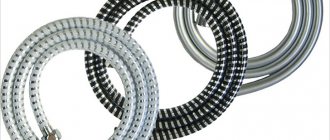Not so long ago, a dishwasher was considered a luxury, and only very wealthy people could boast of it. Today, everything has changed radically, and the dishwasher has become as common a appliance as the washing machine and refrigerator. Its convenience and time savings cannot be underestimated, so if you decide to purchase an “assistant”, you are unlikely to regret the purchase. All that remains is to choose the right model, buy, connect and use!
We will devote this review to the most common 60 cm dishwashers. In the PMM lines from any manufacturer, the 60 cm wide machine is presented in the largest assortment, so there is plenty to choose from. Let's look at the features and selection criteria for such machines and offer a rating of popular models. Our tips will help you figure out which machine is the best.
No. 1. Is there any real benefit to using a dishwasher?
Russian people are wary, sometimes even skeptical, about all new kitchen appliances. And although dishwashers are no longer a new product, they have not become widespread in our country. Perhaps it is only a matter of time, or perhaps there is another reason. Whether you need a dishwasher, you can determine for yourself by studying the advantages and disadvantages of operating this unit.
Advantages:
- saving time and effort . Imagine how much time you have to spend to wash all the dishes after a home party, but instead you really want to relax. If you have a large family, washing dishes every day also takes a lot of time. Dishwasher owners have a huge amount of time freed up, and their nervous system is also stronger, since just the thought of washing a mountain of dirty dishes causes some people to twitch their eyes;
- Washing dishes can be done at any time , even if you are not at home. Many people prefer to turn on the device at night, when electricity is cheaper;
- the presence of hot water is not required - the machine will heat it up on its own, although options for connecting the unit to a source of hot water are possible;
- saving water . The dishwasher uses 3-5 times less water than you do when washing it yourself;
- you can use strong detergents that cannot be used for manual washing;
- Due to the high temperatures, the machine perfectly washes the dishes from “chemicals” and dries them. The quality of washing is excellent and can hardly be compared with manual washing;
- versatility. In the car, in addition to the dishes, you can wash toys, combs, hood filters, stove grates, refrigerator trays and more.
disadvantages :
- The dishwasher quite a lot of space You will have to sacrifice one of the storage areas and consider free access to the door for opening and closing it;
- the need to buy consumables (tablets, salt, rinse aid), but they are more expensive than regular dishwashing detergent;
- itself also costs money , but almost all those who did not skimp and made a purchase admit that the money spent is worth it;
- The machine will not be able to load and unload itself , as well as clean the plates from scraps , so you will have to devote time, albeit a small one, to the process of washing dishes;
- if you need to wash just a few dishes, then do it faster without a machine;
- you will have to remove carbon deposits and stuck-on food yourself, but the machine can handle other contaminants, such as long-term grease deposits, easily;
- Not all dishes can be washed in the dishwasher : crystal can become cloudy, wood can break, and cast iron can become rusty.
When deciding to purchase, you need to evaluate not only your budget and real needs for this unit (for a person who lives alone, or for a family of 2 people, the device is not so necessary), but also the area of the kitchen and the ability to fit a dishwasher into it.
No. 2. Dishwasher installation type
In this case, there are several options, and the choice depends on the size of the kitchen and some other factors:
- built-in dishwashers mounted in the bottom row of kitchen cabinets. The device door is covered with a facade, and all controls are located at its end, i.e. In order to set all the settings, you must open the door. It is impossible to understand that a built-in dishwasher is hidden behind one of the facades. This is the main advantage of this installation method - the kitchen looks harmonious and complete. In addition, the device takes up less space and the noise level will be lower. It is better to choose this option in cases where you are arranging a kitchen from scratch and, in parallel with the machine, you are choosing a kitchen set;
- stationary and partially built-in are not covered by the kitchen facade, they can stand in line with the kitchen cabinets or be located separately from them - as you wish. As a rule, such models are produced in neutral colors: black, metallic, white. The control panel is located on the front of the door, so many people recognize this type of dishwasher as more convenient to use. There is no need to open the unit to start it, and all information about the wash is displayed on the display at the end of the wash. Such models will be appropriate if the kitchen is already equipped or if you don’t want to clearly fix the place of the dishwasher behind the kitchen facade;
- portable countertop dishwashers They are similar in size to a microwave oven, installed on the kitchen countertop and connected to the tap. A good solution for owners of very small kitchens.
No. 3. Size and capacity
It doesn’t take a genius to understand that capacity depends on size, and the choice of capacity depends on how many dishes you have to wash. Capacity is measured in the number of sets of dishes that can be washed in 1 cycle . One set includes three different plates, a cup and saucer, a glass, a knife, a fork and 3 spoons. Dishwashers are designed to wash 4-17 sets of dishes, but it all depends on the dimensions of the device:
- full size machines They are 60 cm wide (height 85 cm, depth 60 cm), designed for washing 11-17 sets of dishes, have flexible internal filling, are suitable for large families, but take up a lot of space. Often such models are equipped with an increased number of modes;
- narrow cars have a width of 45 cm (rarely less) with the same height and depth as full-size ones. They are great for small families (for 3-4 people the unit’s capabilities are enough), they save space in the kitchen, and can accommodate 6-10 sets of dishes;
- desktop devices with a width of 45-55 cm have a depth of 48-55 cm and a height of 45-46 cm. As a rule, they are placed on a tabletop or built into a wall cabinet. Capacity - about 2-4 sets of dishes, rarely more. This is an option for the most compact kitchens and very small families. Such models are cheaper than their counterparts, but at the same time the quality of washing is slightly worse.
It is better not to take a car with back-to-back capacity. Keep in mind that you will also have to wash pots and pans, and sometimes there will be guests in the house.
Performance Comparison Charts
When compiling the rating, we created graphs with the characteristics of all the cars included in the TOP 10. We decided to bring them to your attention so that you can clearly see which car suits you best and why.
Price
Electricity consumption
Noisiness
Programs
No. 4. How many programs are really needed?
Manufacturers generously equip dishwashers with various modes. Their number can be up to 17, although the most inexpensive units may have only 2. More does not mean better. It is important that the car has the following driving modes:
- normal;
- intensive, used for washing heavily soiled dishes at a temperature of 65-750C;
- fast, suitable for washing dishes with light stains, while saving water and electricity can reach 20%;
- with pre-soaking – a mode that allows you to first soak the dishes without detergents, and only then start washing. Suitable for heavily soiled dishes;
- Economy mode is suitable for lightly soiled dishes;
- The mode for washing fragile dishes will allow you to safely clean glasses and porcelain.
The machine may also have a half-load mode designed to clean a small amount of dishes. The sterilization function will definitely come in handy for young parents and women preparing for the winter. It is convenient to have a delay start function : you can load the dishes in the evening and set everything up so that washing occurs at night, and in the morning clean dishes will be waiting for you. If there are children in the family who are at an age when they are interested in knowing and exploring everything, it is better to take a car with a child lock feature.
Among the additional functions and options there may be the following (how necessary they are is up to you):
- waste crusher;
- The Aqua Stop function will protect the kitchen from flooding if software failures occur. Useful addition;
- automatic mode detection allows the machine to supposedly assess the degree of workload and select the optimal and most economical washing mode. This is a privilege of expensive models, but even in them the function is poorly implemented;
- Possibility of connection to hot water . Usually the dishwasher is connected to cold water supply and sewerage (it is advisable that the distance to the entrance to the sewerage system be no more than 1.5 m). Cold water is heated to the required temperature due to the operation of heating elements. Some models can connect to a source of hot water, and the amount of energy consumed by the machine is reduced;
- self-cleaning filter . Food residues settle on a special collector, which must be cleaned from time to time. Expensive cars can do this on their own without your intervention.
Which dishwasher to choose, with a minimum of modes or only the most necessary ones, is up to you to decide. It all depends on the intended manner of operation.
Additional functions
In addition to the main programs, PMM may have additional functions. Their availability and set varies depending on the model and price segment.
Let's look at the most common ones.
Extra rinse
A useful option that allows you to repeat the rinsing step after the wash program has completed.
With this, you can better treat the dishes with rinse aids, and also thoroughly wash all the remaining detergents from them.
Additional rinsing after the main cycle can be repeated even more than once.
Automatic door opening after cycle completion
Opens the door after finishing washing.
This helps prevent the formation of mold and mildew in the PMM, promotes complete drying of the dishes and the washing chamber from residual moisture, and prevents the appearance of an unpleasant odor from the machine.
Delicate mode
Designed for washing thin glass, porcelain, and valuable fragile dishes.
The mode provides for washing with slightly heated water. Ideal for washing glasses.
Beam on the floor
This expensive feature is designed for fully embedded PMM models.
It allows you to project a luminous point onto the floor, which lights up or goes out at the end of the wash. In a more complex design, a timer is displayed on the floor showing the time until the end of the cycle.
This option is needed so that users are notified in a timely manner about the end of the PMM operation.
Display
The digital display allows you to fully control the washing process.
It displays all the details of the wash cycle, time remaining, error codes and much more.
Key lock
This is protection against children and accidental clicks.
If you pre-set the lock before the wash cycle, then when you press the buttons during operation, they are locked.
The option is not available in all PMMs. You need to find out in advance about its availability in a specific model.
Leak protection
An indispensable component for the safe operation of dishwashing equipment.
This feature detects water leakage from the dishwasher and initiates a chain of operations to stop the water supply.
Auto mode
This program allows you to minimize human participation in the dishwashing process.
The user simply needs to indicate the degree of contamination, and the machine itself will select the washing parameters.
In more advanced options, you don’t even need to specify anything: with the press of one button, automatic sensors recognize the level of dirt and regulate the washing process themselves.
Quiet mode
Allows you to reduce the noise of dishwashers. Thanks to this, you can turn on the machine even at night, and it will not disturb your sleep.
If a two-phase meter is installed, then purchasing a PMM with a quiet mode is doubly justified. This way you can pay less for light and get a good night’s sleep: there will be no noise from the sink.
Other additional options
In addition to the features described above, the PMM has a delayed start function, a sound alarm at the end of the cycle, soaking, a program for washing children's dishes, auto-detection of water hardness and other features.
As a rule, more expensive devices have more functionality.
About
No. 5. Consumption of water and electricity. Energy class
When buying an expensive device, you not only want to get rid of the daily routine work, but also not go broke on water and electricity bills, so when purchasing, it is important to pay special attention to water consumption and energy saving class. By the way, these two parameters are interrelated (the less water is consumed, the less electricity is required), so together they allow us to judge the efficiency of the device.
The water consumption standard for 1 cycle for a modern dishwasher is 14-15 liters. The most economical ones spend only 8-9 liters, but at the same time they cost more. Old models had a water consumption of 20 liters and today are considered completely uneconomical. An honest manufacturer must indicate the water consumption rate in both normal and economical modes. Both numbers need to be taken into account.
The energy class is indicated by a letter from A to G. Devices of classes A, B and C are considered economical, and all others are considered outdated, too powerful or professional. It is already difficult to find class C devices on sale, not to mention more “gluttonous” ones. of classes A+, A++ and even A+++ appeared on sale The more pluses, the less energy the unit will consume and the more expensive it will cost.
Average energy consumption by class:
- class A – 0.8-1.05 kWh/cycle;
- class B – 1.06-1.09 kWh/cycle;
- class C – 2-2.99 kWh/cycle.
If your apartment has a two-tariff meter, but by choosing an economical dishwasher and turning it on at night, you can reduce all costs to a minimum.
Control system
Mechanical controls are familiar to older people - these are buttons and rotary mechanisms, like on a gas or electric stove. It is advantageous in free-standing dishwashers, where protruding elements will not interfere with closing the door and will not stand out against the general background.
More modern and expensive models with a large number of additional modes and functions have electronic control in the form of a touch display and buttons. In fully built-in machines, the display is displayed on the front side of the door, in partially built-in machines it is located on the front panel.
No. 6. Washing quality class
The classes evaluate not only water consumption, but also how well the machine copes with its immediate responsibilities. There are models of classes A, B, C, D and E. However, today even the most inexpensive units provide washing class A. This means that the dishes will be washed very well. If you want an ideal result, you can take an A+ or A++ , but it will cost more.
The quality of washing is affected by the number, size and shape of sprayers supplying water. The more there are, the better, and the thinner the holes, the more accurate the jet will be. Another factor is the number of directions for water supply. The principle also works here: the more, the better. In addition, these jets should not interrupt each other. This is a guarantee that you will be able to wash all the dishes loaded into the machine and the so-called problem will not arise. dead zones.
However, the design alone is not enough to ensure high quality washing - a lot also depends on the water . The lower the water hardness, the better the dishes will be washed, and much less detergent will be needed. If your water pipes have hard water and you have not yet installed a filter, then you will have to add regenerating salt to the dishwasher.
Criteria for choosing a 60 cm dishwasher
To compile the TOP 10 best freestanding dishwashers, it is worth comparing them according to a number of basic characteristics. Often, according to some parameters, a car occupies a leading position in the ratings, but according to others, it ranks at the very bottom. Of course, the ideal model has not yet been invented, but from the huge assortment on the household appliances market, you can choose the best option for even the most demanding buyer.
Before compiling the TOP cars, let’s understand the criteria by which the models were evaluated.
Dishwashing quality
This is the main parameter for which this equipment is purchased. The price of a PMM that won’t wash the dishes is worthless. How to evaluate the quality of the washing process? According to two indicators: washing and drying class.
Important! Manufacturers often overestimate the real performance of their products, so you should not completely believe their advertising videos - you need to additionally read real customer reviews.
If you need a productive and functional machine, go for class A - both washing and drying dishes.
Reliability
This characteristic is difficult to assess, and it consists of a number of factors. Thus, truly reliable models are unlikely to have plastic containers for utensils - good manufacturers equip their appliances with stainless steel baskets. The same goes for the tank - in a reliable PMM it will be made of high-quality metal.
Such a parameter as reliability can also be judged by the presence of a system that protects against leaks - it can be either partial or complete. The number of user requests to workshops and repair forums also forms an indicator of reliability.
Price
This is not the most objective, but often the decisive criterion when choosing a 60 cm dishwasher. Every second buyer would not refuse to buy good products at the lowest price. Both low and high prices should confuse you equally.
Important! The price often does not reflect the quality of assembly and PMM parts, but the popularity of the brand. Even expensive options from well-known brands can break.
Functional
According to this parameter, machines are divided into two types:
- Standard: with a limited set of modes.
- Advanced: with a large selection of programs and additional options.
It is not the number of programs and modes that is important, but their usefulness. If you are not going to use even half of the functions offered by the manufacturer, is it worth paying extra for them?
No. 7. Drying type and class
Drying washed dishes is the final stage of the entire process. It depends on him whether there will be stains on the surface of the plates and glasses or not.
Depending on the type of drying, dishwashers are:
- condensation _ Here drying occurs almost naturally. The dishes are rinsed with hot water and dried, while condensation accumulates on the walls of the machine and flows into a special compartment. The device will not signal the end of work until it finishes drying, which means the process will be quite long. This type of drying is used in simpler machines. It is good because it does not consume electricity. If you load the dishwasher in the evening and turn it on overnight, you will not notice any inconvenience associated with the drying time;
- drying due to the accumulation of heat generated during washing can significantly shorten the process, but at the same time not make it more energy-intensive;
- forced drying , or turbo drying, is carried out due to the presence of a fan in the machine, which blows warm air over the washed dishes, which significantly reduces the duration of the washing cycle. This type of machine is suitable for those who will turn on the wash several times a day. For example, if the family is large, and the kitchen only has room for a dishwasher that is only 45 cm wide, then most likely you will have to frequently do two washes a day.
Drying efficiency is also designated by classes A to G. Class A is typical for machines with forced drying; dishes after washing in such devices have a pleasant smell and literally squeak from cleanliness.
Compact assistant
The smallest of the proposed options are available in sizes 45X55X45 centimeters. This dishwasher is convenient to place on a work surface, but it can handle no more than six sets of dishes at a time. They will perfectly complement a bachelor pad, and can be installed in an office.
Please note: the set of dishes includes seven units - plates for the first, second, salad, bread and dessert, two spoons and forks each. There is no question of cups, which means that you will either have to wash them separately or reduce the number of wash sets.
No. 8. Type of leakage protection
All dishwashers receive leak protection, but it can be of two different types:
- the full protection system stops the water supply when it detects damage to the hoses or a slight excess of water inside the machine;
- partial protection is triggered when a special pan is overfilled with water. Such cars are cheaper.
So which dishwasher is better to choose so as not to overpay and not flood the kitchen? It all depends on the type of ceilings and flooring in the kitchen. If the floors are wooden, and the floor is decorated with laminate or parquet, then it is definitely worth taking a car with full protection. If tiles or porcelain stoneware are laid on the floor, then you can get by with partial protection, although complete protection, of course, will be preferable in any case.
Videos that you won't get bored with)
Useful tips on products, cleaning, first start, icons, etc.
How and who invented the dishwasher. Aren't you interested?)
OK it's all over Now. If the article was useful and you liked it, rate it, bookmark it, share it with friends on social networks and leave comments) All at once or even just one thing is not important. Just let me know that my efforts were not in vain)
The text is completely original. Copying any elements of the article is possible only with an active link to the source!
No. 9. Noise level
The quieter the machine is, the more expensive it is, but if you have a studio apartment, a kitchen combined with a living room, or you are a light sleeper, then it is better not to skimp. The quietest dishwasher produces a noise level of about 38 dB. The average value is 44-45 dB , this noise can be compared to a normal conversation. There are cars that produce noise up to 55 dB, and this is already uncomfortable.
For those who especially value silence, cars are produced with additional sound insulation. When choosing such a unit, you should carefully evaluate the dimensions of the device, which can be significantly increased due to the presence of an additional layer of sound insulation.
Tip 10. Consider whether you need sound insulation
The dishwasher is rightfully considered one of the noisiest electrical appliances. If the kitchen is isolated from the living areas and your house has good sound insulation, this issue is not so pressing - it can even be ignored.
There are no absolutely silent dishwashers
It’s worse if you want to install a dishwasher in a Khrushchev-era building, a new panel building or a studio apartment.
In this case, you should pay attention to the actual noise level in the product characteristics. In fact, each manufacturer can call the soundproofing option differently, and sometimes attribute it to where there is almost no sound insulation.
Therefore, evaluate the device based on real numbers. It is best to choose models with readings from 47 to 57 decibels.
Summary: The quieter the model, the more expensive it is. Therefore, if there is no need for silence, you can ignore this factor.
No. 11. Basket
The comfort of using the dishwasher will depend on the configuration of the basket. Today, all models on the market are equipped with two-level baskets. The upper level is for plates, glasses, cups, the lower level is for frying pans, pots, trays and other large utensils.
It’s good if the dishwasher allows you to adjust the height of the second level and change the tilt of the basket. It’s even better if there are trays for small cutlery and special baskets for knives. All this will allow you to wash more efficiently, place dishes of different types and sizes inside the machine, and get clean plates, pots and cutlery at the end.
No. 12. Dishwasher Manufacturers
Among the most affordable dishwashers on the market are models produced by Ardo, Whirlpool and Indesit . Gorenje, Hotpoint-Ariston and Candy have proven themselves to be of excellent quality and low cost . Bosch, Electrolux and Siemens remain the traditional leaders in terms of quality , but dishwashers from these brands are also more expensive, although quite budget models can be found in their model lines. They will be distinguished by a basic set of functions and a consistently high level of quality. Miele appliances belong to a higher price segment and often feature enhanced functionality.
Experts say that an indirect sign of a high-quality dishwasher is its substantial weight. If the manufacturer has saved and abused the abundance of plastic parts, then the device will weigh suspiciously little.
The article was written for the site.
Tags:Kitchen











